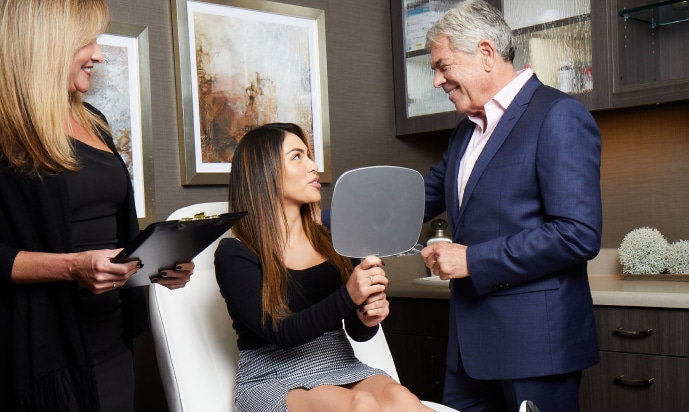The Art of Altruism
November 13, 2008
Selfless acts not only create a solid reputation among patients, they make life-altering differences for those unable to afford corrective surgery
Nichter performs a comprehensive consultation, which is essential in ensuring a successful outcome
It costs more than $40,000 each time Larry S. Nichter, MD, MS, FACS, flies to a third world country to devote as much as 3 weeks to teaching physicians abroad how to perform various plastic and reconstructive procedures. However, that money only covers the tangible expenses, like transportation and equipment. Not included is the potential income Nichter forfeits by being away from is southern California-based practice, the Pacific Center for Plastic Surgery. For Nichter, altruism is what drives him to participate in these medical missions, which to date, has been more than 30 times in his career.
“Most of us who go into medicine do so with a desire to accomplish wonderful things by helping people in need,” says Nichter, who is board certified by the American Board of Plastic Surgery, the American Board of Surgery, and has certification of added qualifications in hand surgery.
“But somewhere along the line, a lot of us become disillusioned by the harsh realities of running a practice. By making altruism a formal part of my practice, I have been able to avoid disillusionment and burnout. For example, when I return from an overseas mission, I have a greater appreciation of my family, staff, and patients because I realize how fortunate we are that we don’t live in grinding poverty where access to even the most basic medical care is often unavailable.”
Nichter’s deeds are not confined to foreign shores, however. He is a firm believer that charity begins at home. ” A short time ago, I spent half a day in surgery with a neurosurgeon to work on a child suffering from a very unusually shaped head,” he says. ” No bills were sent afterward. I did this purely as a labor of love.”
Nichter’s practice partner, Jed Horowitz, MD, FASC, board certified by the American Board of Plastic Surgery, explains that taking care of indigent patients is something the two have always opted to do. “Providing life-changing care to those who cannot afford it is a great source of satisfaction for us,” Horowitz says.
In some instances, it turns out to be less of a financial strain on the practice to provide free treatment than it would be to charge for services. “We are very dedicated to collecting financial data so that we have a clear picture of its fiscal health,” says Nichter. ” We discovered that with our state’s Medic-aid patients, we were losing significant sums of money because of the expense involved in documenting, submitting, tracking, and, if necessary, appealing claims. We looked at what it cost to provide treatment divorced from the cost of jumping through all of the insurance hoops and found that we were better off giving away our services to those patients.”
Altruism is also beneficial by the goodwill it engenders among the public. According to Horowitz, prospective patients tend to feel more certain about using the services of practitioners with a solid reputation for selfless acts.
Performing surgery in the ambulatory center and hospital setting is equally important, according to Horowitz.
“Thanks in part to our reputation in the community, we have been able to build a large – albeit informal – referral network that supplies us with a reasonably steady stream of new patients in need of complex reconstructive services, ” says Horowitz.
“There are fewer and fewer plastic surgeons willing to take on the challenges of complex reconstructive patients these days, so our referral sources are understandably appreciative that they have us to see their patients.
Even with this network, the practice has observed a shifting emphasis from reconstructive work to cosmetic procedures. “It is a natural evolution that most practices experience as time progresses,” says Horowitz. “Today, cosmetic procedures are about 60% of our work.”
Horowitz’s and Nichter’s aesthetic-oriented expertise includes breast enhancements, breast reductions, breast lifts, upper -and lower-eyelid surgery, laser resurfacing, chemical peels, nose reshaping, liposuction, and tummy tucks, and they periodically perform their procedures as a team. Most often these cases involve bilateral procedures, such as breast enlargement and breast reduction. “If a breast enlargement takes one doctor 3 or 4 hours, we can complete that same procedure in half the time by working in tandem,” says Nichter. “This is advantageous for our patients because the shorter duration of surgery means less risk of morbidity and nausea.”
Where Paths Cross
Both Nichter and Horowitz- who met and became friends as plastic surgery residents at the University of Virginia, Charlottesville – have practiced in southern California since 1985, although separately at first. That year, Horowitz joined an established Long Beach practice of a solo plastic surgeon. It was based in 1,100-bed tertiary hospital, which ensured the practice a large volume of referrals. “Because of our hospital location and, in part, because I had gained a clinical appointment at nearby University of Southern California, Los Angeles, we sought to position ourselves as an academic-oriented practice, but in a private setting,” says Horowitz. “Our capabilities were such that we could perform all of the cutting-edge reconstructive and cosmetic procedures offered by university-based groups.”
Nichter likewise held a full-time teaching post at USC, which he acquired upon arriving in Los Angeles. Several years later, Horowitz convinced him to join the same hospital-based group. Following Nichter’s recruitment, the practice grew to six plastic surgeons working from four locations.
Problems arose when managed care muscled its way to become the dominant force in financing health care services. “Managed care adversely impacted our business plan,” Horowitz recalls. “Health plans did not care that we could provide all these quality services; they just wanted to contract with the lowest-priced provider they could find. As a result, our patient volume decreased, and the economies of scale we had achieved as a sizable group ceased working for us.”
In 2000, the group disbanded. However, Horowitz and Nichter decided to stick together. “We looked at our options and realized we worked well together as a team,” Horowitz says. Horowitz and Nichter purchased the old group’s locations in Huntington Beach and Newport Beach, Caliornia., and downsized the staff to trim costs. They also scrutinized the managed care contracts they still individually held, dropping those that were the most economically disadvantageous. They did the same with the hospitals at which they had privileges, but for logistical reasons.
“We were doing surgeries at a dozen hospitals spread across the market,” says Horowitz. “We reduce that number after we realized that the commute time between surgical appointments was limiting our productivity.”
Today, they perform surgeries in about half as many hospitals as before. However, the majority of operations now take place in an ambulatory surgery center they helped establish in Huntington Beach.
Take the Next Step
To learn more about the innovative treatments offered at Pacific Center for Plastic Surgery in Newport Beach, CA, contact our office by calling (949) 617-1168 or by filling out the consultation request form below.
“We formed a joint-venture partnership with one of the local hospitals and a management company that operates more than 300 ambulatory surgery centers around the country.” Horowitz asserts it is a plus to still be performing a significant number of cases in hospital setting rather that solely in the ambulatory surgery center. “When you only perform surgery in a self-contained facility, you lose the opportunity to interact with other physicians in your community,” he says. Nichter adds, “Being in the workplace of those other physicians and letting them see what you do on a routine basis is the best form of marketing.”
Nichter and Horowitz prefer marketing that is personal. For example, some months back, they set up displays at various upscale department stores to demonstrate their computer imaging capabilities to interested shoppers. At one of the stores, they hosted an event billed as “Gentlemen’s Night Out,” a guys-only affair where attendees received tips from the physicians and noteworthy health and beauty experts on how to look good, all while enjoying food, spirits, and good cigars.
Altruism at Work
Because overseas medical missionary work expenses are so high, Nichter established a nonprofit entity 4 years ago by the name of Plasticos Foundation as a vehicle for supporting and perpetuating this facet of his practice. Although Plasticos Foundation does not have professional fundraisers, the need to recruit some has been a matter of discussion at recent board meetings. Currently, Plasticos Foundation generates operating capital through a casual network of donors – mainly patients – who are aware of the organization through conversations with the physicians or by reading about it in the waiting rooms. Some have even elected to contribute after seeing the 1997 Oscar-winning video A STORY OF HEALING, which spotlights Nichter as the leader of a medical mission to Vietnam under the auspices of Interplast, the oldest and perhaps the best-known of the nonprofit organizations involved in arranging and underwriting medical missionary trips.
It was by happenstance that Nichter, a longtime Interplast member, ended up leading that mission to Vietnam. Another Interplast physician was to go but he was sidelined at the last minute. A Denver-based film crew was to accompany the group, and Interplast officials asked Nichter to step up to the plate, an assignment he happily undertook. “I was really thrilled when A STORY OF HEALING won at the Academy Awards,” says Nichter. “It was competing in the category of best documentary short subject, and was going up against several big budget, professionally produced IMAX films.”
“The success of our foundation is directly effected by donations both monetary and that of supplies and equipment,” according to Dr. Nichter. While the award proved beneficial for public awareness, the Plasticos Foundation and its southern California chapter of Interplast continue to be in need of donations, especially following the September 11th tragedy. The operating expenses for our missions are extensive, with the help of generous supporters our missions continue to help hundreds of deserving individuals.
Recently, Nichter and Horowitz donated medical reference books for distribution to third world physicians and nurses. “While many of the foreign lands we visit have brilliant and talented surgeons, they are nevertheless technique-starved; we hope our book donation will help address this,” says Nichter, who describes the medical libraries in those countries as virtually non-existent.
“On our Plasticos Foundation Sponsored trips, we often work under difficult and primitive conditions, correcting deformities such as cleft palates, webbed hands or feet, burn scars, tumors, and the like. As we operate, we simultaneously train local surgeons, anesthesiologists, and nurses in reconstructive surgical techniques and patient care, so their work can continue long after our team has gone home. The reason we focus on training through Plasticos Foundation is that we believe in the ancient Chinese proverb, if you give a man a fish, he eats for a day, but teach him how to fish, and he eats for a lifetime.”
Larry S. Nichter, MD, MS, FACS, the founder of Plasticos Foundation, began performing reconstructive surgery and training local surgeons in the treatment of congenital deformities, trauma care, burn, and hand reconstruction in 1987. Since then, he has undertaken more than 25 missions to various countries around the world.
Mission Statement: To provide reconstructive plastic surgical training and care to those in need, regardless of their ability to pay, and to advance the field of plastic surgery through education and research. Making a life-altering difference:
- $100 will buy medicine for a child
- $250 will buy medical supplies for a child
- $700 will fund a surgery for one child
- $3,000 enables one physician or nurse to operate overseas for 2 weeks
- $5,000 will buy surgical instruments for a typical trip
- $30,000 funds entire surgical mission including 12 medical professionals
- An endowment of $750,000 will fund one yearly trip forever
To donate or learn more contact:
Plasticos Foundation
7677 Center Ave, Ste 401
Huntington Beach, CA 92647
714-902-1100 ext 135
www.plasticosfoundation.org
Take the Next Step
As soon as you step into our Newport Beach office, our welcoming staff will carefully listen to your concerns and guide you through your treatment journey. The board-certified plastic surgeons at Pacific Center for Plastic Surgery will be happy to discuss your cosmetic goals, review the pros and cons of the treatment you are considering, and create a personalized treatment plan that will deliver the best outcome for you.
To learn more about the innovative treatments offered at Pacific Center for Plastic Surgery in Newport Beach, CA, contact our office by calling (949) 617-1168 or by filling out the consultation request form below.





